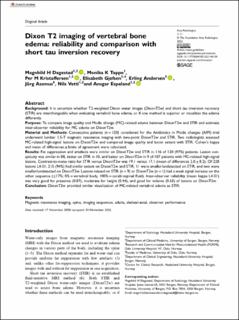| dc.contributor.author | Dagestad, Magnhild Hammersland | |
| dc.contributor.author | Toppe, Monika Kolskår | |
| dc.contributor.author | Kristoffersen, Per M | |
| dc.contributor.author | Gjefsen, Elisabeth | |
| dc.contributor.author | Andersen, Erling | |
| dc.contributor.author | Assmus, Jörg | |
| dc.contributor.author | Vetti, Nils | |
| dc.contributor.author | Espeland, Ansgar | |
| dc.date.accessioned | 2023-02-03T14:10:06Z | |
| dc.date.available | 2023-02-03T14:10:06Z | |
| dc.date.created | 2023-01-13T14:17:05Z | |
| dc.date.issued | 2022 | |
| dc.identifier.issn | 0284-1851 | |
| dc.identifier.uri | https://hdl.handle.net/11250/3048370 | |
| dc.description.abstract | Background
It is uncertain whether T2-weighted Dixon water images (DixonT2w) and short tau inversion recovery (STIR) are interchangeable when evaluating vertebral bone edema, or if one method is superior or visualizes the edema differently.
Purpose
To compare image quality and Modic change (MC)-related edema between DixonT2w and STIR and estimate inter-observer reliability for MC edema on DixonT2w.
Material and Methods
Consecutive patients (n = 120) considered for the Antibiotics in Modic changes (AIM) trial underwent lumbar 1.5-T magnetic resonance imaging with two-point DixonT2w and STIR. Two radiologists assessed MC-related high-signal lesions on DixonT2w and compared image quality and lesion extent with STIR. Cohen's kappa and mean of differences ± limits of agreement were calculated.
Results
Fat suppression and artefacts were similar on DixonT2w and STIR in 116 of 120 (97%) patients. Lesion conspicuity was similar in 88, better on STIR in 10, and better on DixonT2w in 9 of 107 patients with MC-related high-signal lesions. Contrast-to-noise ratio for STIR versus DixonT2w was 19.1 versus 17.1 (mean of differences 2.0 ± 8.2). Of 228 lesions L4-S1, 215 (94%) had similar extent on DixonT2w and STIR, 11 were smaller/undetected on STIR, and two were smaller/undetected on DixonT2w. Lesions missed on STIR (n = 9) or DixonT2w (n = 1) had a weak signal increase on the other sequence (≤17%; 0% = vertebral body, 100% = cerebrospinal fluid). Inter-observer reliability (mean kappa L4-S1) was very good for presence (0.87), moderate for height (0.44), and good for volume (0.63) of lesions on DixonT2w.
Conclusion
DixonT2w provided similar visualization of MC-related vertebral edema as STIR. | en_US |
| dc.language.iso | eng | en_US |
| dc.publisher | Sage | en_US |
| dc.rights | Navngivelse-Ikkekommersiell 4.0 Internasjonal | * |
| dc.rights.uri | http://creativecommons.org/licenses/by-nc/4.0/deed.no | * |
| dc.title | Dixon T2 imaging of vertebral bone edema: reliability and comparison with short tau inversion recovery | en_US |
| dc.type | Journal article | en_US |
| dc.type | Peer reviewed | en_US |
| dc.description.version | publishedVersion | en_US |
| dc.rights.holder | Copyright The Foundation Acta Radiologica 2022 | en_US |
| cristin.ispublished | true | |
| cristin.fulltext | original | |
| cristin.qualitycode | 1 | |
| dc.identifier.doi | 10.1177/02841851221146130 | |
| dc.identifier.cristin | 2106658 | |
| dc.source.journal | Acta Radiologica | en_US |
| dc.identifier.citation | Acta Radiologica. 2022. | en_US |

